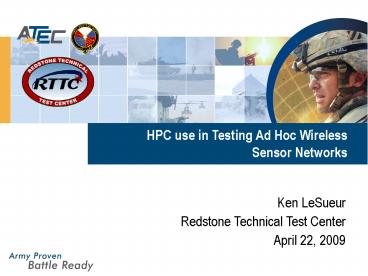HPC use in Testing Ad Hoc Wireless Sensor Networks - PowerPoint PPT Presentation
Title:
HPC use in Testing Ad Hoc Wireless Sensor Networks
Description:
Networked sensors and sensor fusion systems ... terrain model, interference modeling, jamming/attacks, power/battery model, data ... – PowerPoint PPT presentation
Number of Views:101
Avg rating:3.0/5.0
Title: HPC use in Testing Ad Hoc Wireless Sensor Networks
1
HPC use in Testing Ad Hoc Wireless Sensor
Networks
Ken LeSueur Redstone Technical Test Center April
22, 2009
2
Wireless Sensor Network Testbed
Wireless Sensor Network Testbed
- Need Realistic testing of wireless tactical
networks - Networked sensors and sensor fusion systems
- Networked systems require the network to
stimulate the system, unlike stand alone systems
that can be tested in isolation - A real-time network emulation with interfaces to
real systems that forces perception and response
as they would in the real world - Current test methods are not adequate for testing
tactical wireless network hardware in realistic
battlefield environments
2
3
Proposed Approach
Proposed Approach
- Combine
- Parallel computing resources
- Scalable, high fidelity network emulation
- Computer Generated Forces (CGF) model
- Testing of sensor hardware is facilitated by
Network emulation that will allow interfacing of
sensor hardware with virtual components to
produce operationally realistic numbers of
network nodes - 5,000 to 10,000 for a future Brigade Combat
Team
3
4
Example of Multi-Layered Network
Example of Multi-Layered Network
4
5
Example of Multi-Layered Network
Example of Multi-Layered Network
UAS
Networked Missiles
UGV
Sensors
UGS
5
6
Tactical Scenario
Tactical Scenario
Track Msg (WNW)
Detection Msg
EO/IR Node
Track Message (SRW)
Gateway Node
6
7
Tactical Scenario
Tactical Scenario
Detection Msg
EO/IR Node
Track Message (SRW)
Gateway Node
7
8
Tactical Scenario
Tactical Scenario
Fire Msg (WNW)
Detection Msg
EO/IR Node
EO/IR Command Msg
Gateway Node
8
9
General Requirements
- Interface to real tactical network hardware
- Real-Time Operation
- Parallel Implementation to scale for large
number of nodes - Support for Military standard Joint Tactical
Radio - Systems (JTRS)
- Soldier Radio Waveform (SRW)
- Wideband Networking Waveform (WNW)
9
10
Test Bed Design
Test Bed Design
Network Simulation (QualNet)
Sensor Hardware
HWIL Interface
Wireless Network Interface
In-band Stimulation
Node Positions On Terrain
Physical Stimulator
Computer Generated Forces Model (OneSAF)
- Infrared
- Visible
- Seismic
- Acoustic
10
11
Unattended Ground Sensor Example
Tactical Unattended Ground Sensor
QualNet Network Simulation
Gateway Node
SRW Wireless Interface
Ethernet
HPC
In-band Acoustic/Seismic Stimulation
Node Positions On Terrain
11
12
System Configuration
Delivery/Integration August 2009
12
13
Subsystem Test Analysis Branch Facilities
Distributed Test Control Center (DTCC) / High
Performance Computer (HPC) Labs
- Capabilities
- Spans from Pure Simulation to Hardware
Integration - Utilizing HWIL Assets for both Lab and Field
Environments - Classified and Unclassified Networking and
Computing - 92 Microprocessors and Access to HPC Resources
- Advanced Multi-User KVM Switching to All
Computers - Fiber Links to All RTTC Labs and Ranges
- Defense Research Engineering Network (DREN)
- Connection (OC-12 with OC-3 Guaranteed)
- Host of Simulation, Visualization, Network
Monitoring - and Data Recording Software Suites
HPC Lab
HPC Control Area
Bullets
DTCC
DTCC
14
Initial Testbed Efforts
Results
- Analysis of scalability of Network emulation and
HWIL testing/simulation - Analysis of performance as a function of fidelity
(path loss modeling, terrain model, interference
modeling, jamming/attacks, power/battery model,
data acquisition, etc.)
14
15
Test Setup
Test Setup
- Purpose Evaluate number of Nodes, number of
processors, and simulation complexity on
real-time testing. - HWIL interfaces linking live video
Server/Client - UDP Generator Rude/Crude used for quantitative
measurements - 512 kbps UDP/Video Stream
- 802.11 wireless protocol
- 2 Mbps wireless subnets
- Monitor Real-time performance while adjusting
number of nodes, subnets, and background traffic
15
16
HWIL Interface
HWIL Interface
- Virtual Node
- Simulated Node
16
17
Performance Data
Performance Data
17
18
Performance Data
18
19
Performance Data Cont.
19
20
Conclusion
Conclusion
- Using the scenarios outlined in this testing,
approximately 750 simulated wireless network
nodes can be simulated on a two processor
computer while simultaneously interfacing to two
external HWIL networked systems passing live
streaming video - Parallel efficiency is approximately 65 for a
1000 node scenario running on 2 processors
(Expand when HPC delivered) - Performance thresholds can be measured but the
results are highly scenario dependent
20






























